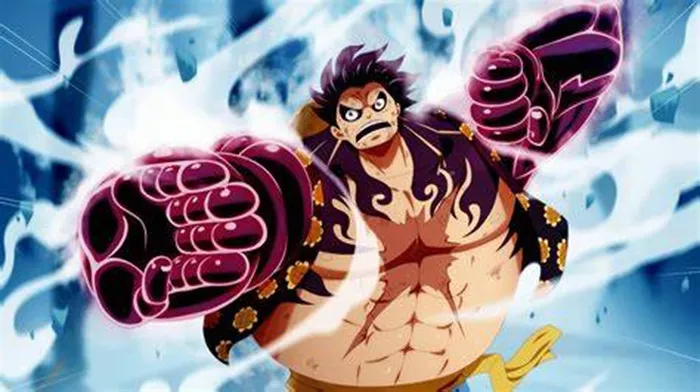In the expansive universe of One Piece, Monkey D. Luffy, the protagonist and captain of the Straw Hat Pirates, showcases a remarkable ability to adapt and grow stronger through various combat techniques known as “Gears.” Among these, Gear 4 stands out as one of Luffy’s most powerful transformations. Introduced during the Dressrosa Arc, Gear 4 is not just a simple upgrade; it represents a significant evolution in Luffy’s fighting capabilities, combining speed, strength, and agility in unprecedented ways.
The Origin of Gear 4
Luffy first activates Gear 4 in Chapter 784 of the manga and Episode 726 of the anime during his intense battle against Donquixote Doflamingo. This moment is pivotal not only for Luffy’s character development but also for the narrative of One Piece, as it marks a turning point in his ability to confront formidable foes. The training Luffy underwent during the two-year time skip with Silvers Rayleigh on Rusukaina Island laid the groundwork for this transformation. It was here that he honed his skills and learned to manipulate his rubbery body to its fullest potential.
How Gear 4 Works
To activate Gear 4, Luffy bites his arm to inflate his muscles with air while simultaneously coating himself in Busoshoku Haki (Armament Haki). This process allows him to significantly increase his size and strength while maintaining his agility. Unlike previous Gears, where specific body parts were inflated or enhanced, Gear 4 involves a full-body transformation, giving Luffy a more balanced increase in power.
The mechanics of Gear 4 are fascinating; Luffy essentially turns himself into a giant balloon made of rubber and steel. This unique combination allows him to deliver devastating blows while also providing enhanced durability against attacks. The use of Haki not only amplifies his offensive capabilities but also serves as a protective layer against powerful foes.
Forms of Gear 4
Gear 4 is versatile and consists of several sub-forms, each designed for different combat scenarios:
1. Boundman: The original form of Gear 4, Boundman focuses on increasing Luffy’s speed and strength. In this form, he constantly bounces off surfaces, allowing him to maintain momentum and deliver rapid attacks. His body becomes significantly larger, with reinforced limbs coated in Haki, enabling him to absorb and deflect incoming attacks.
2. Tankman: Introduced during the Whole Cake Island arc against Charlotte Cracker, Tankman showcases Luffy’s defensive capabilities. In this form, he inflates himself even further after consuming large quantities of biscuits, transforming into a massive tank-like figure. This form sacrifices mobility for incredible durability, allowing Luffy to withstand powerful blows while delivering counterattacks.
3. Snakeman: This form emphasizes speed and agility over brute strength. Snakeman allows Luffy to deliver rapid punches that can change direction mid-flight, making it difficult for opponents to predict his attacks. This form was notably used in his battle against Charlotte Katakuri, where speed was essential to counter Katakuri’s advanced Observation Haki.
Each form has its strengths and weaknesses, providing Luffy with a strategic advantage depending on the opponent he faces.
See Also: Does Robin Love Luffy?
Limitations of Gear 4
Despite its immense power, Gear 4 comes with significant drawbacks. The most notable limitation is the toll it takes on Luffy’s body. The activation of Gear 4 requires substantial amounts of Haki, which leads to exhaustion after prolonged use. Once Luffy deactivates this form, he becomes vulnerable for a period as his Haki reserves are depleted.
Additionally, Luffy cannot use Haki for approximately ten minutes after using Gear 4 due to the intense strain it places on his body. This vulnerability can be exploited by clever opponents who recognize the timing of Luffy’s transformations.
The Impact of Gear 4 on Battles
The introduction of Gear 4 has dramatically altered the dynamics of battles within One Piece. It has allowed Luffy to confront some of the strongest characters in the series effectively. For instance, during his fight with Doflamingo, Gear 4 enabled Luffy to turn the tide after initially struggling against Doflamingo’s String-String Fruit abilities.
Luffy’s ability to combine speed with overwhelming power has made him a formidable opponent even against those who possess advanced Devil Fruit powers or exceptional combat skills. The versatility offered by the different forms within Gear 4 means that Luffy can adapt his fighting style based on the challenges he faces.
Conclusion
Gear 4 represents a significant milestone in Monkey D. Luffy’s journey as a pirate and fighter within One Piece. Its introduction not only showcases Luffy’s growth but also emphasizes the themes of perseverance and adaptation that are central to the series. As fans continue to follow Luffy’s adventures, it will be intriguing to see how he further develops his abilities and what new challenges await him in the world beyond the Grand Line. Through rigorous training and determination, Luffy has transformed into one of the most powerful characters in anime history. As One Piece progresses towards its conclusion, fans eagerly anticipate how these abilities will evolve and what new forms may emerge from this iconic character’s relentless pursuit of strength and freedom.
Related Topics
What Is The Last Episode Of One Piece?
What Happens In The First Episode Of One Piece?

